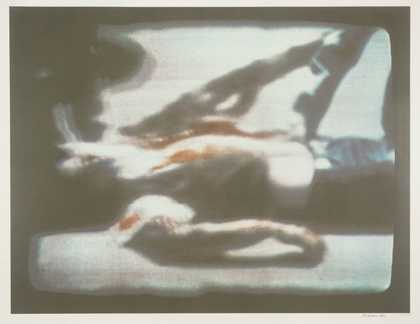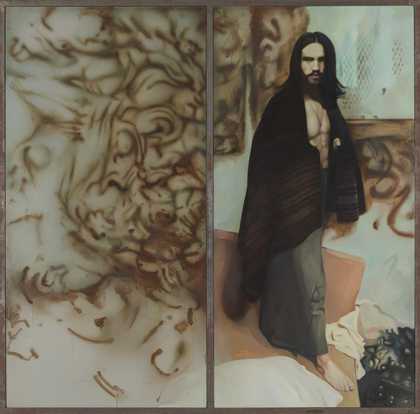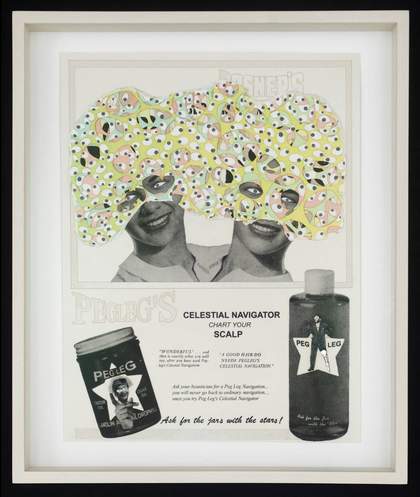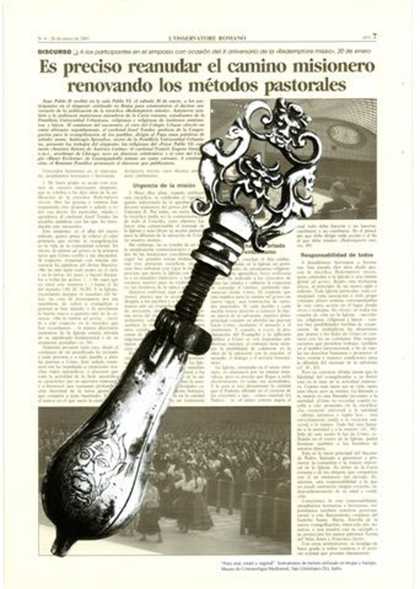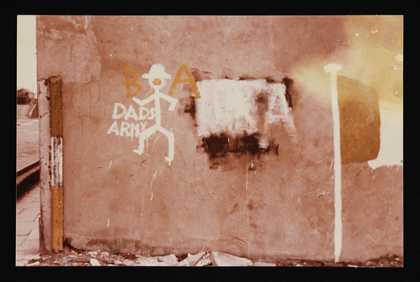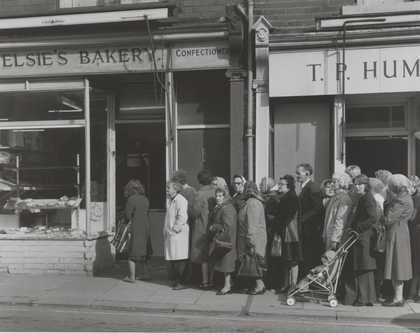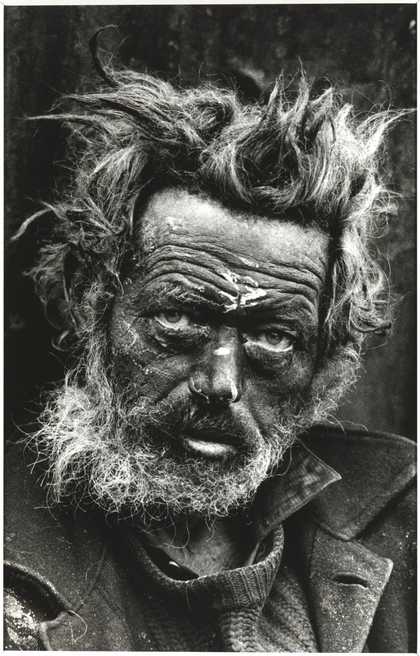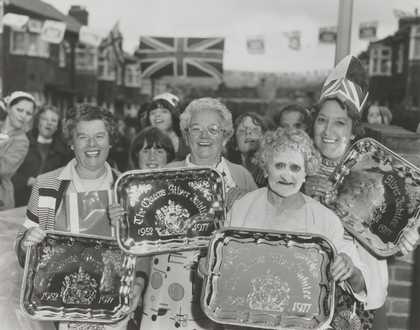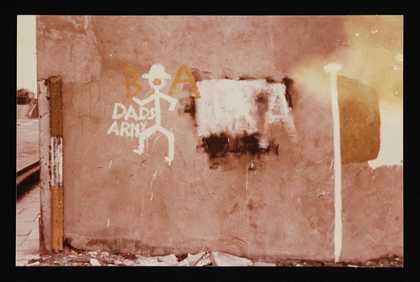Introduction
This resource looks at some of the ways artists respond to events and issues in the news. Some, such as war artists, document these events. Others use their art as a powerful tool to raise awareness of issues in the news and hope to change people’s minds. For many artists, making art is a way of expressing their feelings about news stories – whether anger, sadness or excitement. How news is reported and circulated is also something many artists explore through art, often adopting approaches used by the media their message across.
In the Headlines
Media pics
Artists Richard Hamilton, Marlene Dumas and William Sasnal often use photographs of events from the media as sources for their paintings. By reinterpreting these photographs using the physical qualities of paint, they present the images in a new light. We see the subjects in a different way and are made to reflect on our usual habits of looking at everyday photographic images.
Hamilton’s Kent State 1970 was painted from a photograph of a TV screen taken during a news report. The report was about police action against student demonstrators protesting against America’s involvement in the Vietnam War. For The Citizen 1981–3 he used stills from a 1980 news report about IRA prisoners. Photographs of celebrities in the news were also used by Hamilton. His Swingeing London series uses newspaper coverage of pop star Mick Jagger as its source.
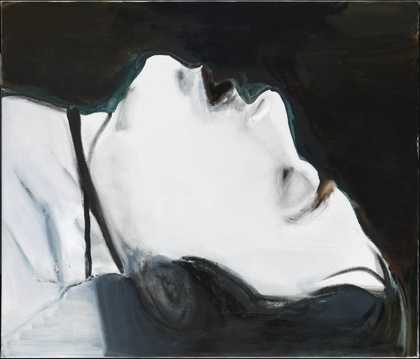
Marlene Dumas
Stern (2004)
Tate
Stern by painter Marlene Dumas shows a stark image of a head. The painting is based painting on a photograph from a news article in German magazine Stern about Red Army Faction terrorist Ulrike Meinhof who was found dead in her prison cell in May 1976.
It is not just official news sources that artists turn to for their photographic sources. The increased availability of mobile technology means that significant events are now often routinely captured by bystanders and circulated online.
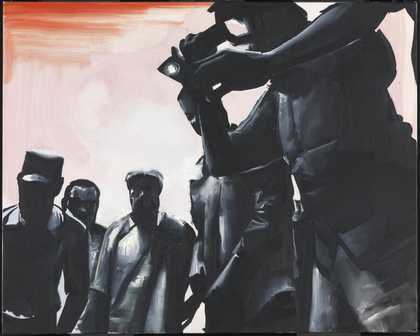
Wilhelm Sasnal
Gaddafi 2 (2011)
Tate
Gaddafi 2 2011 is one of three paintings by William Sasnal based on images that emerged in the media following the death of Libyan dictator Muammar Gaddafi. The painting shows a group of rebel fighters apparently looking at Gaddafi’s body, which cannot be seen due to the close cropping of the image. One of the figures seems to be filming the event.
Artist Sonia Boyce also uses images from the media – from newspapers, magazines and films – in her artwork From Tarzan to Rambo ...
In the mixed-media work she explores her identity or sense of herself in relation to media depictions of blackness and whiteness. It looks at the complex interweaving of black history with classic Hollywood narratives and other mass cultural forms.
Find out about Boyce's ideas, techniques and use of images from the media in this Look Closer resource.
Read all about it
While a photograph is a record of one moment, a newspaper is a record of one day so is always fixed in time. It becomes a poignant reminder of the events that happened that day.
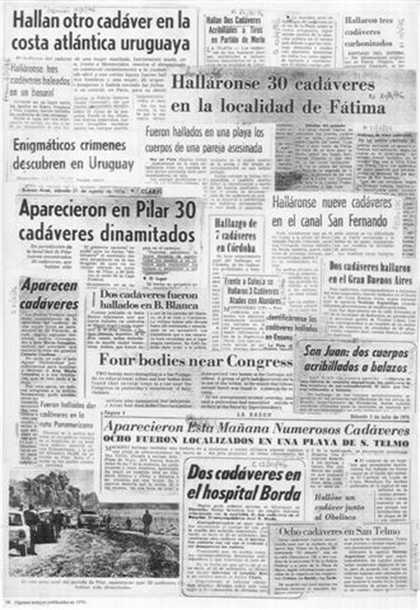
León Ferrari
News Articles Published in 1976 (1995–6, 2007)
Tate
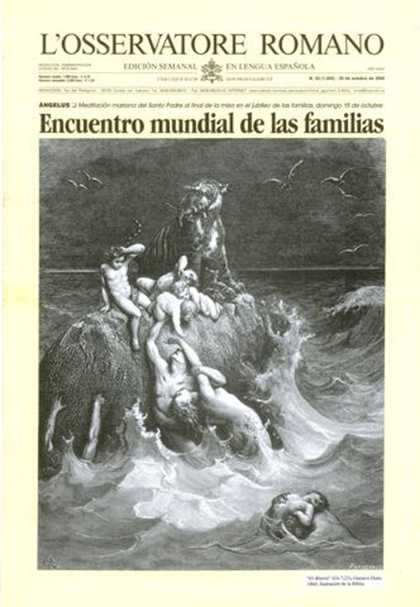
León Ferrari
[no title] (2001, reproduced 2007)
Tate
Artist León Ferrari often used news articles in the form of newspaper clippings in his work. He explored stories relating to political and religious corruption in Argentina in the 1960s and 70s, often juxtaposing newspaper cuttings with other photographs or historical prints.
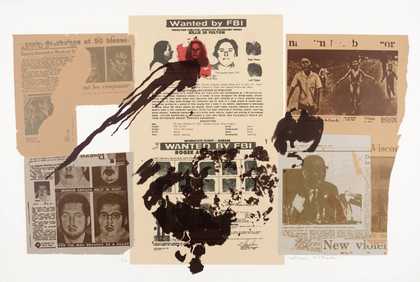
Michael Rothenstein
Violence I (first version) (c.1973–4)
Tate
Michael Rothenstein also used newspaper clippings directly. In his Violence series of prints the clippings are spattered with paint – suggesting his frustrated or angry response to the stories in the news.
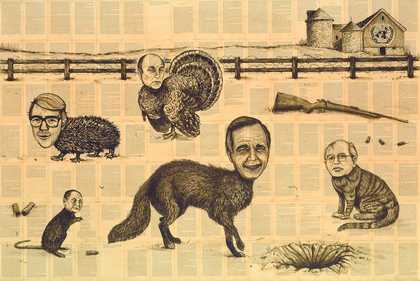
Tim Rollins and K.O.S. (Tim Rollins 1955–2017)
Animal Farm - New World Order (1989–92)
Lent from a private collection 2000
© Tim Rollins and K.O.S. Courtesy the artists and Lehmann Maupin, New York and Hong Kong

Tim Rollins and K.O.S. (Tim Rollins 1955–2017)
Animal Farm - G7 (1989–92)
Lent from a private collection 2000
© Tim Rollins and K.O.S. Courtesy the artists and Lehmann Maupin, New York and Hong Kong
Tim Rollins makes uses of a different kind of clipping to comment on people in the news. Pages of George Orwell’s book Animal Farm provide a painting surface. Published in 1945, Animal Farm was a comment on politics and power. Orwell used animals to represent the different characters. The allegorical political story has been updated by Rollins with animals representing contemporary world leaders of the time.
Documenting Events
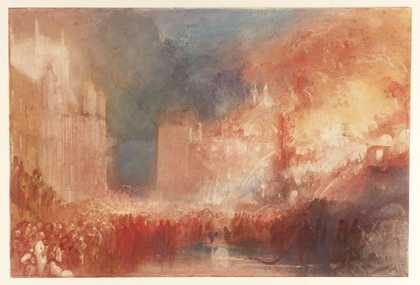
Joseph Mallord William Turner
The Burning of the Houses of Parliament (c.1834–5)
Tate
As well as commenting on events in the news, artists also often document events. In doing so their personal responses to what they have witnessed become part of the documentation.
Sometimes, the artist just happened to be there – as was Turner when there was a fire in the Houses of Parliament J.M.W. Turner. He dashed down to the river, jumped on a boat and painted the dramatic scene.
War artists
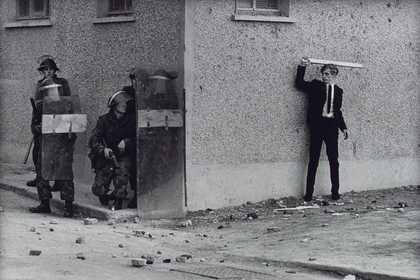
Sir Don McCullin CBE
Northern Ireland, The Bogside, Londonderry (1971, printed 2013)
ARTIST ROOMS Tate and National Galleries of Scotland
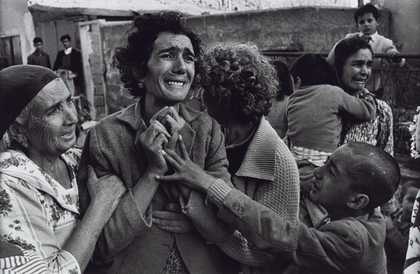
Sir Don McCullin CBE
Cyprus (1964, printed 2013)
ARTIST ROOMS Tate and National Galleries of Scotland
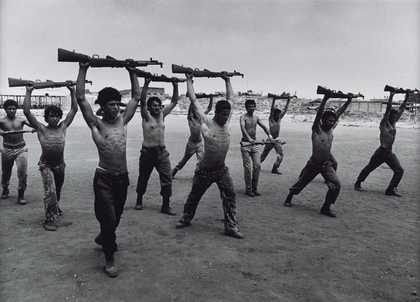
Sir Don McCullin CBE
Palestinians Training in West Beirut (1970s, printed 2013)
ARTIST ROOMS Tate and National Galleries of Scotland
Artists are often commissioned to record events. For example official war artists are sent to war zones to document what they see. Photographer Don McCullin is one of the most important war photographers of the twentieth century. His devastating images of conflict zones and the casualties of war in Vietnam, Berlin and Northern Ireland don't just provide documentation of what happened. Many have become iconic images symbolising the devastating impact war has on individuals and societies. He sees his photographs as a ‘silent protest against the futility of war’. In this TateShots video he talks about how he went about capturing and recording these events.
During the Second World War, Graham Sutherland was one of many artists commissioned to record the devastation caused by bombing raids. His paintings are not realistic depictions of hat he saw. Instead what he felt when he saw the bombed out buildings is clearly expressed in the colours and expressive marks he uses.
Ordinary lives (extraordinary circumstances)
Documenting the news is not just about capturing dramatic events. Often artists look at how big news events impact on the lives of ordinary people, or explore the personal stories that make it into the news.
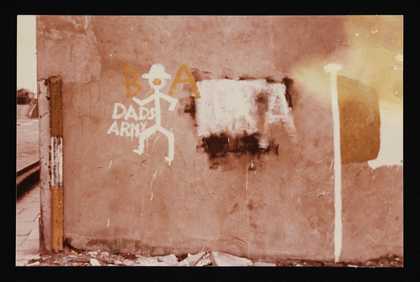
Conrad Atkinson, Colour photograph of a wall in Northern Ireland painted with a stick man, an Irish flag, and the words, ‘Dads Army’ c. 1978
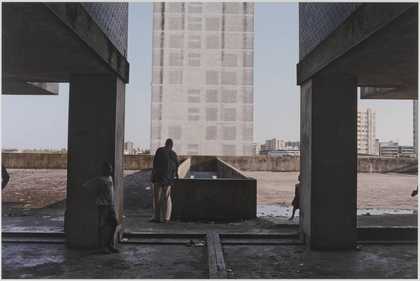
Guy Tillim
Apartment building, Avenue Bagamoyo, Beira, Mozambique (2008)
Tate
Conrad Atkinson’s photographs record everyday scenes in Northern Ireland during the troubles there in the 1970s. Graffiti, posters, and protests are among the subjects he captures. While Guy Tillim, in his powerful photographs of derelict buildings that were once functional and grand, records the impact of years of war and political unrest in Central Africa.
Stories of desperate refugees fleeing war torn countries are very much in the news now. But refugees fleeing conflict or persecution is not just new news. Luc Delahaye's powerful photograph of a refugee camp among ruined buildings in 2002 provides a shocking image of what life for displaced people is like.
Gerald Pryse's Untitled (Refugees Sheltering among Ruins) c.1917 shows refugees during the First World War. Although relating to a conflct that is 100 years old, the image of ordinary people made homeless by war and sheltering in make-shift ruins, sadly seems very familiar to us today.
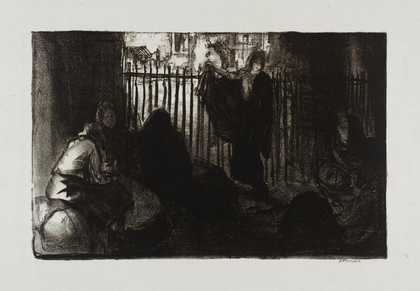
Gerald Pryse
Untitled (Refugees Sheltering among Ruins) (c.1917)
Tate
It is not only war and conflict that affects people's lives and makes it into the news. In his prints, James Boswell responds to personal tragedies. The Means Test 1934 shows a suicide victim. In 1931, the government introduced the Means Test which affected thousands of people who were out of work by taking away their unemployment benefit. This had tragic consequences on the lives of people who relied on benefits to survive. Boswell's Murder on Gosfield Street refers to a real murder that happened in London in 1942. Boswell's slightly cartoon-like style of drawing makes the events depicted seem even more shocking.
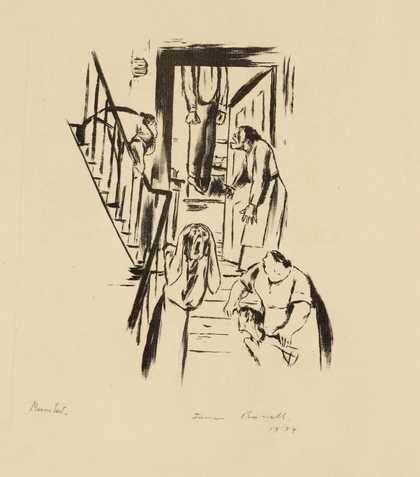
James Boswell
The Means Test (1934)
Tate
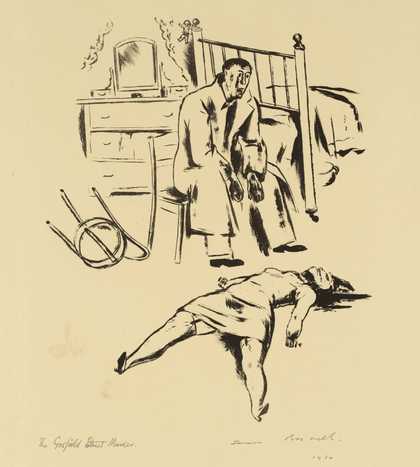
James Boswell
Gosfield Street Murder (1942)
Tate
Symbolic Responses to News Stories
Artists don’t always respond to news events through narrative depiction. They often create artworks that symbolise the impact that events have on them and how the events make them feel. These artworks become a type of tribute or memorial.
One of the worst atrocities of the Spanish Civil War was the bombing of a Basque town called Guernica in 1937. Pablo Picasso responded to the massacre by painting a vast mural called Guernica. The painting is about the horror and pain suffered by the victims and is often seen as one of the most powerful anti-war artworks. A weeping woman holding her dead child which appears in the mural is used by Picasso again and again in other artworks to symbolise horror and suffering. The spiky abstraction Picasso uses to depict her, powerfully suggests the raw emotion he felt in response to the event.
Chris Ofili also uses a crying woman as a symbol of a horrific event. No Woman No Cry 1998 is a tribute to the London teenager Stephen Lawrence who was murdered in 1993 in a racially motivated attack. In each of the tears shed by the woman in the painting is a collaged image of Stephen Lawrence’s face. The words ‘R.I.P. Stephen Lawrence’ are just visible beneath the layers of paint. As well as a specific reference to Stephen’s murder, the artist also intended the painting to be read as a universal portrayal of melancholy and grief.
Artists Theaster Gates and Teresa Margolles use very direct symbolism in response to events in the news.
Civil Tapestry 4 2011 looks a bit like an abstract painting. But If you look closely you see that it’s made from old recycled fire hoses. The work is a kind of memorial to a horrific event that took place in Alabama in 1963. Young black school children were marching peacefully to demonstrate for equal rights, when fire hoses were turned on them. The powerful jets of water injured lots of the children. Theaster Gates uses the fire hoses to symbolise this awful event.
Flag I 2009 by Teresa Margolles was made in response to the huge numbers of violent deaths in Mexico associated the with powerful drug dealers. The cloth 'flag' contains traces of blood, soil and other substances from the sites of murders.
Watch Zenisha from Tate Collective talk about her response to the work.
This film file is broken and is being removed. Sorry for any inconvenience this causes.
By using objects from the scenes of these events to make their artworks, Gates and Margolles make the events seem more real to us. The artists seem to be saying 'these are not just something you read about in the news – this actually happened – and here is the evidence'. As well as becoming a memorial to those killed or injured, the artworks also act as a powerful of warning. The artists want to make sure that we know about what happened so we can try and stop it from happening again.
News Stories Revisited: Learning from History
For Then & Now 2016 artist Lorna Simpson uses images of a 1967 race riot in Detroit. Shes uses images of this past event to reflect on the legacy of racial violence in the United States today.
Lorna Simpson often uses pictures from newspapers and magazines in her work to explore and challenge the position of African-American women in American culture. In this video she talks to Amandla Stenberg and Mars from youth-led movement #ArtHoe about her fascination with images and how she uses these to put her acfross her ideas.
This film file is broken and is being removed. Sorry for any inconvenience this causes.
Jeremy Deller and Mark Wallinger both restaged past events in the news to raise awareness of some of the issues surrounding them.
Jeremy Deller’s The Battle of Orgreave Archive (An Injury to One is an Injury to All) 2004, is a collection of artifacts and props used to create his short film Event Plan 2001. The project recreates a historical clash between police and striking miners that took place during the miners strikes in the 1980s, as art. Deller used members of the local community and some professional actors for the piece.
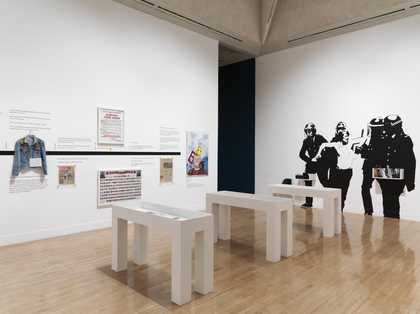
Jeremy Deller
The Battle of Orgreave Archive (An Injury to One is an Injury to All) (2001)
Tate
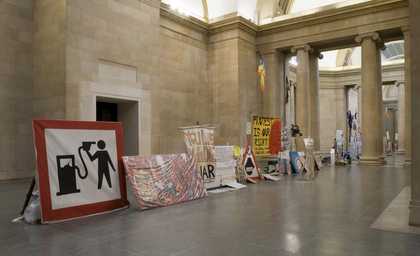
Mark Wallinger
State Britain (2007)
Tate
For his installation State Britain 2007 Mark Wallinger meticulously recreates over 600 anti-war banners, placards and other objects which were set up opposite the Houses of Parliament in opposition to the Iraq war in 2003. Watch Mark Wallinger discuss the work and find out more in this video.
Direct Action! Mass Media and Social Engagement

Guerrilla Girls
Guerrilla Girls Review The Whitney (1987)
Tate
Spreading the word: Posters and flyers
Most of the artists we have explored so far in this resource use their art to raise awareness of issues and events in the news and try and make things change. Some artists go one step further to make their point. They adopt techniques and media aimed at putting their message across to as many people as possible.

Guerrilla Girls
You’re Seeing Less Than Half The Picture (1989)
Tate
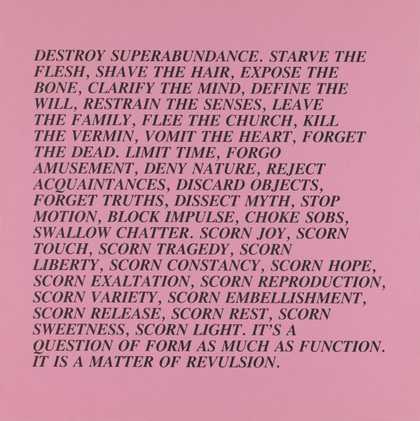
Jenny Holzer
[no title] (1979–82)
Tate
© Jenny Holzer, member/Artists Rights Society (ARS), New York
The Guerrilla Girls, Jenny Holzer and Peter Kennard use media that can be easily reproduced so that they can reach a larger audience.
The Guerrilla Girls use text and simple images in their posters that battle prejudice in the art world. Jenny Holzer also uses posters and signs (as well as billboards, T-shirts, hats, stickers and park-benches) to comment on current social and political issues that she feels strongly about. Her first public works, Truisms 1977–9, were anonymous flyers pasted on buildings, walls and fences in and around New York.
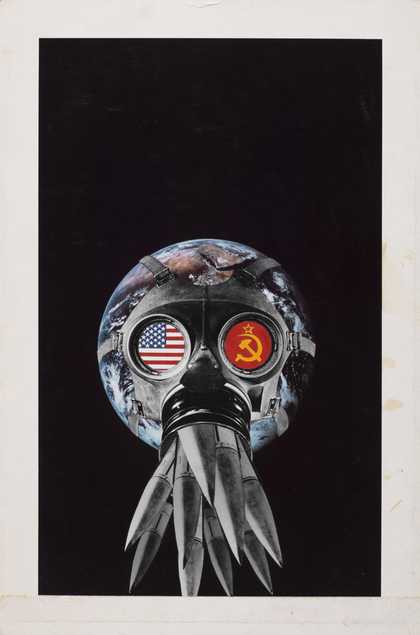
Peter Kennard
Defended to Death (1983)
Tate
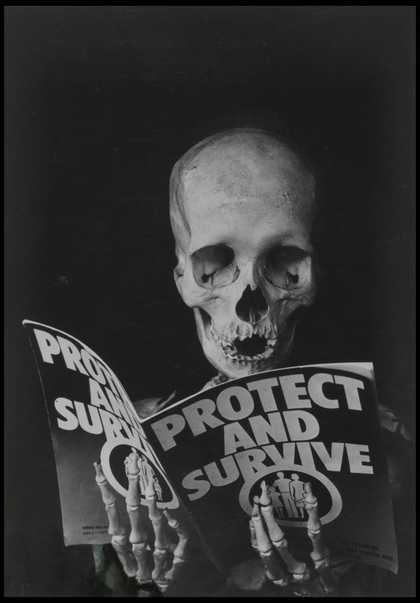
Peter Kennard
Protest and Survive (1980)
Tate
Peter Kennard turned from painting to photomontage – a technique that allows him to more directly put across his political views. The photomontaged images are also easier to reproduce in posters, pamphlets, magazines and online. His aim is:
to encourage people to think about their own situation and activate, but I'm not trying to tell them to do this or that. I'm just trying to show how I see the world at the moment
Kennard is best known for the images he created for the Campaign for Nuclear Disarmament (CND) in the 1970s–80s, when fears of Nuclear War were very real and frequently discussed in the news. More recently he has made work criticising the Iraq War as well as a series of protest posters in response to the 2013 G8 summit in Enniskillen. Kennard encouraged the public to 'print, Tweet, Facebook, email and share these images', seeing online distribution sites as 'a valuable addition to the dissident artists toolbox'. He has also fly-posted these posters in public places, commenting 'if world leaders insist on assaulting our lives and livelihoods, let's hit back by assaulting their eyes.'
Get everyone involved!
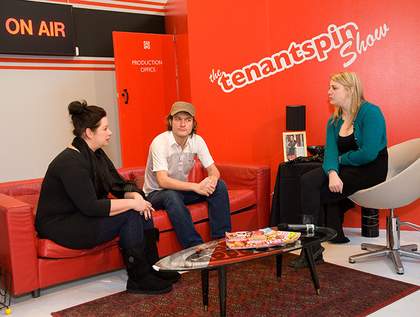
Image courtesy of Tenantspin and FACT
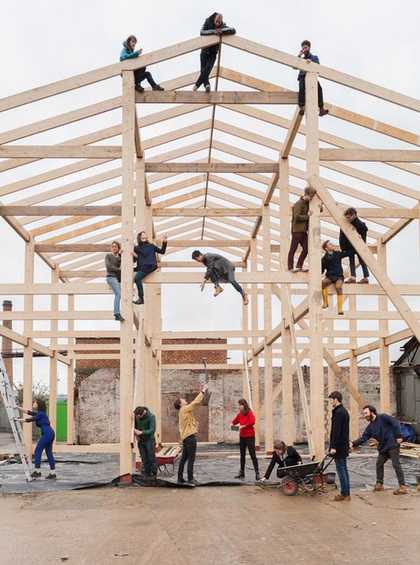
Assemble Assemble Group Photo 2014 © Assemble
The term socially engaged practice is used to describe artists who collaborate or work or with specific communities. Their work is usually about raising awareness of social issues with the aim of helping to make life better. These artists use a range of media and approaches in getting communities to join in. Superflex, established a Community TV Channel in 1999 called tenantspin. The TV channel is a collaboration between a number of housing associations in Liverpool and a technology foundation. Tenantspin also provide media training for community groups.
Assemble are a collective of artists, designers and architects who collaborate with local residents in order to improve housing. Watch Assemble talk about what they do:
This film file is broken and is being removed. Sorry for any inconvenience this causes.
Performance and intervention
In the work of Cuban installation and performance artist Tania Bruguera, images familiar from the news ‘become real life experiences' re-enacted inside museums or galleries. She sees art as something that should have a real effect in society as part of everyday life, and uses it to comment on political structures. In her performances she often adopts the sort of methods that governments and other systems of power use to control people.
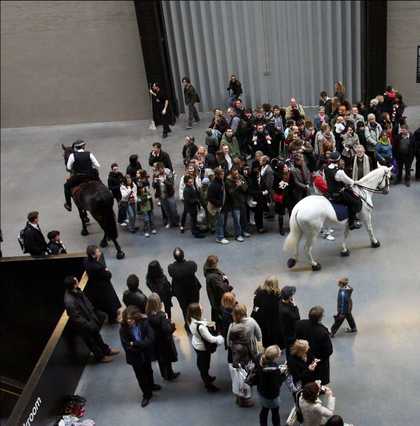
Tania Bruguera
Tatlin’s Whisper #5 (2008)
Tate
Bruguera's ongoing art project, Immigrant Movement International aims to explore who is defined as an immigrant, the values they share and how they are treated.Tatlin’s Whisper #5 is a performance work in the series. During the performance, two mounted policemen in uniform (one on a white horse and one on a black horse) are brought into the museum. They patrol the space, guiding and controlling the audience by using crowd control techniques. The exits and entrances to the museum are blocked, so the audience is at the mercy of the mounted police.
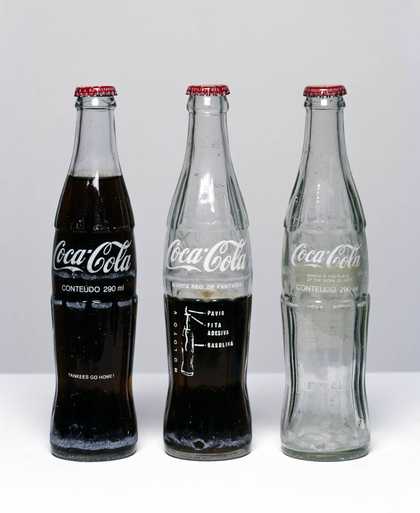
Cildo Meireles
Insertions into Ideological Circuits: Coca-Cola Project (1970)
Tate
Cildo Meireles is another artist who uses direct action to raise awareness of political issues. For his Insertions into Ideological Circuits: Coca-Cola Project 1970, he altered a series of Coca-Cola bottles, printing slogans on them that attacked Brazil's military dictatorship. When empty the slogans are not visible, but when the bottles are recycled and filled with coke again the slogans become visible. So the system of recycling empty bottles became a way of enabling political messages to secretly circulate. Meireles described the work as an act of subversive ‘mobile graffiti’.
Have a go
We’ve pulled together some ideas to help you get started:
Photo re-make
Richard Hamilton, William Sasnal and Marlene Dumas all used found images of news stories circulated through the media to create their paintings. By painting the photographs they become less throwaway and we look at them in a new light.
We are bombarded with images daily. On social media, in newspapers, and on the TV. Collect images from the media about a news story that is important to you.
Re-make the image using paint, drawing materials or collage. How does re-working the image change how it appears?
Making the Cut
Use newspaper clips or cuttings from current stories in the news to make a collage.
- Put these cuttings next to each other, layer them or add other photographs or images to them. (These could be pictures from fashion or lifestyle magazines, from adverts or your own photographs).
- What is the effect of juxtaposing different stories and clips?
- Does the impact or meaning the news stories change if you put them next to images from other sources?
- Try working into your collage with paint, drawing materials or mixed media. Look at Ellen Gallagher's collages for ideas.
(You could also use your computer and picture editing tools to make a digital collage or moving image collage)
As it happens: Documenting the news
This resource has looked at how artists have documented events. These are often global news stories such as wars or stories relating to refugees.
- Local events and issues are also news worthy.
- Find out what events are happening in your area. This could be a local football match, a concert, a meeting or demonstration, or a visit to your local area by a celebrity or VIP. How would capture and put across what happened at the event? Photograph or film the event and use the photographs as the starting point for your artwork.
- Local news stories may be not be one-off events but issues relating to homelessness, vandalism, or traffic pollution. How woould you document an issue such as this?
- If the event or issue is something that affected you – made you excited, sad, or angry – think of ways of putting this across in your artwork.
Symbolic responses to news stories
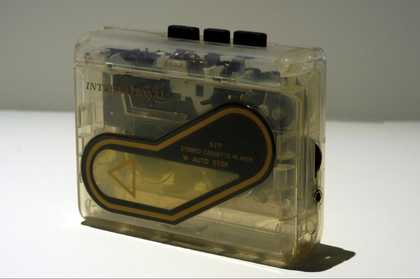
Lamia Joreige
Objects of War No.2 (2003)
Tate
Have you read or heard something on the news that deeply affected or moved you? This could be something recent or something that happened in the past
Think of ways you could use imagery or objects to symbolise the event and what it means to you.
This could be through an object or image that you associate with the news story.
Get your voice heard

Guerrilla Girls
Guerrilla Girls Review The Whitney (1987)
Tate

Peter Kennard
Defended to Death (1983)
Tate

Jenny Holzer
[no title] (1979–82)
Tate
© Jenny Holzer, member/Artists Rights Society (ARS), New York
Look at the way artists such as the Guerrilla Girls, Jenny Holzer and Peter Kennard used imagery and media to get their message out there.
- Design a poster, T-shirt or tote bag that reflects your response to a news issue or something you feel strongly about.
- It needs to be attention grabbing as well as putting your message across.
- How would you circulate your message and get it out there?
- You could also think about forms of visual media that are used to circulate messages or ideas online such as gifs, memes or ad campaigns. How would you make use of these approaches to get your message heard?

